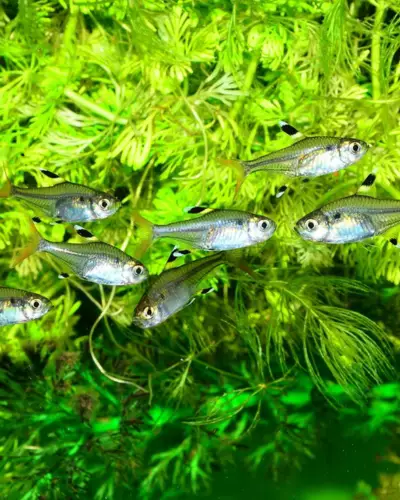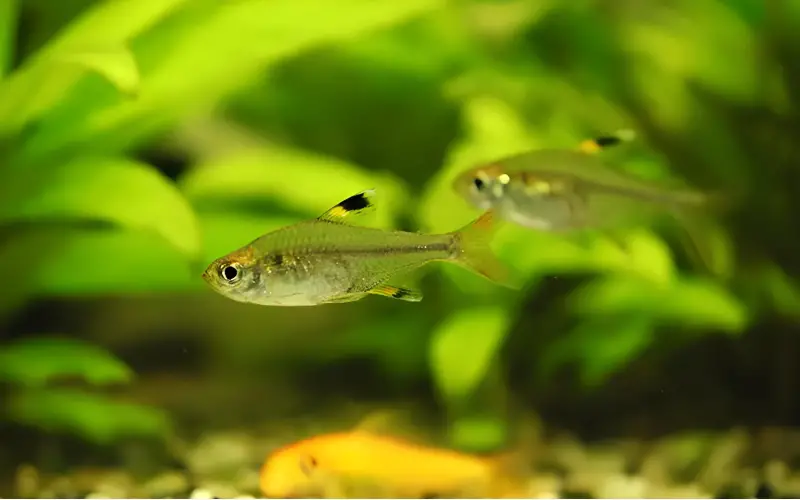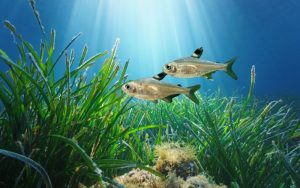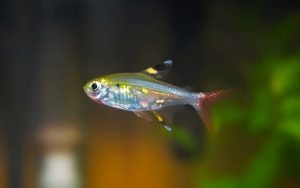Imagine a school of fish, their shimmering bodies seemingly translucent, revealing intricate bone structures that dance with every flick of their fins. That’s the magic of the X-ray tetra, a captivating creature that transports us to the depths of the Amazon. But replicating the X-ray tetra Habitat in your own aquarium isn’t just about aesthetics—it’s about ensuring their health and happiness.
By creating a suitable environment that mimics their native waters, X-ray tetras will thrive and display their vibrant colors and natural behaviors.
The bony structure inside its transparent body, known as the Weberian apparatus, makes the X-ray tetra special.

This blog post will delve into the secrets of this vibrant underwater ecosystem, revealing how to create a thriving environment that mimics the Amazon’s wonders, complete with lush vegetation, a gentle current, and the perfect balance of water parameters.
Get ready to embark on a journey of discovery as we unlock the keys to bringing the Amazon’s beauty and charisma into your living room.
Table of Contents
ToggleBrief Overview of X-Ray Tetra Habitat in The Wild:
The X-ray tetra, scientifically known as Pristella maxillaris, is a fascinating fish that inhabits the coastal waters of the Amazon in South America, specifically in Brazil, Guyana, and Venezuela.
The natural x ray tetra fish habitat is characterized by:
- Blackwater Rivers: These are rivers stained a dark tea color by tannins leached from decaying leaves and wood. This creates a dimly lit environment with low pH and soft water.
- Dense Vegetation: X-Ray Tetras thrive in environments with abundant plants, providing cover, hiding spots, and spawning sites. They particularly favor dense clumps of submerged vegetation and fallen branches.
- Gentle Currents: The Amazon’s blackwater rivers often have gentle currents that are ideal for these active and playful fish.
- Slightly Acidic Water: The water in their natural habitat is somewhat acidic, with a pH ranging from 5.5 to 7.0.
- Soft Water: The water is also soft, with low mineral content.
Understanding these key elements of the X-ray tetra’s natural environment will help us recreate a thriving and healthy x ray tetra fish habitat in our aquariums.
Where Do X Ray Fish Live?
The X-ray fish is a small freshwater fish also known as the golden pristella tetra. Native to the coastal basin in South America, this aquatic species is among the 100 other tetra species in the region.

The x-ray fish is an omnivorous species, feeding on worms and other small food sources. They are known for their translucent skin and bony internal structure, including the yellow, black, and white dorsal and anal fins. Their small size and peaceful nature make them popular among aquarium enthusiasts.
The x-ray fish is typically found in the tributaries and streams of the Amazon basin, where it thrives in freshwater conditions. As schooling fish by nature, they are often kept in schools of six or more.
Monitoring the tank water quality regularly, especially during the dry season when levels may fluctuate, is essential to ensure the x-ray tetras’ optimal health.
Breeding these beautiful fish in a breeding tank can be a rewarding experience, as the females give birth to live young within a few days of fertilization.
What Do X Ray Tetra Eat?
X-ray tetras are omnivores that primarily feed on small aquatic creatures like pencil fish, daphnia, and brine shrimp. They also consume aquatic plants and algae.
In captivity, they can be fed live or frozen. When kept in a proper environment, X-ray Tetras breed quickly. Once they hatch, the fry becomes free-swimming.
Females are generally responsible for guarding and caring for eggs. Therefore, it is important to provide them with the appropriate care to ensure their well-being.
X Ray Tetras have a sense of hearing and use their Weberian apparatus to pick up sound waves in the water. They are native to streams and tributaries in South America and are most active during the rainy season.
These fish are part of a group of species that give birth to live young rather than laying eggs. X-ray tetras are susceptible to habitat loss and decreased water quality, which can impact their internal organs and skeletons. Providing a safe and stress-free environment for X-ray tetras is essential to their survival.
Is the Pristella Maxillaris Species of Tetra Adaptable?
Yes, the Pristella Maxillaris, with its transparent skin, is a highly adaptable fish species. It is known for its hardiness and can thrive in various water conditions.
Here’s what makes them adaptable:
- Water Parameters: They can tolerate more water hardness, pH levels, and temperatures than other tetras. While they prefer soft, slightly acidic water, they can adjust to conditions somewhat outside this ideal range.
- Diet: They are omnivores and will readily accept a variety of foods, including flakes, pellets, frozen brine shrimp, and bloodworms.
- Tank Mates: They are peaceful fish and can be kept with other peaceful community fish. However, they can become skittish if kept with slightly larger predatory fish.
Their adaptability makes them a good choice for both beginner and experienced aquarists. They are relatively easy to care for and can add a touch of beauty and activity to any freshwater aquarium.
Replicating the Natural X Ray Tetra Habitat & Water Parameters in Aquarium
To keep your X-Ray Tetras (Pristella maxillaris) happy and healthy, it’s crucial to replicate the water conditions they’re accustomed to in their natural Amazonian habitat. Here’s a breakdown of the critical water parameters:
- pH: Aim for a slightly acidic pH range of 5.5 to 7.0. This can be achieved using a combination of driftwood, peat moss, and water conditioners.
- Hardness: X-ray Tetras prefers soft water with low mineral content. An ideal general hardness (GH) range is 2-8 dGH.
- Temperature: Maintain a consistent temperature of 72-82°F (22-28°C).
Other Considerations:
- Water Changes: Regular water changes are essential for maintaining water quality. Aim for 25% water changes weekly.
- Cycling: Ensure your tank is cycled adequately before introducing your X-Ray Tetras. This establishes beneficial bacteria that break down harmful ammonia and nitrite.
- Filtration: Use a high-quality filter to keep the water clean and oxygenated. Over-filtration can be detrimental, so adjust filter flow as needed.
By carefully managing these water parameters, you’ll create an environment that resembles the X-Ray Tetra’s natural habitat, promoting their overall well-being and vibrant colors.
Some Possible Fish Tank Mates for X ray Fish
Finding the perfect tank mates for your x-ray tetras can be a fun challenge. Due to their small size and peaceful nature, they do well with other small fish that won’t see them as a tasty snack.
X-Ray Tetras are peaceful schooling fish that thrive in well-planted aquariums with other peaceful community fish. Here are some ideal 10 gallons tank mates for them:
- Other Small Tetras: Neon, Cardinal, and Ember Tetras—These colorful fish share similar water parameter preferences and schooling behaviors, creating a dazzling display in the tank.
- Rasboras: Harlequin Rasboras, Schuchert’s Rasboras—These peaceful, small-sized Rasboras complement the X-Ray Tetras well. They add a pop of color and occupy the mid-water level of the tank.
- Honey Gouramis: These small Gouramis are known for their peaceful temperament and vibrant colors. They prefer the upper tank levels, leaving plenty of space for the X-Ray Tetras to go to school in the middle zone.
- Corydoras Catfish: Panda Corydoras, Pygmy Corydoras – These bottom-dwelling scavengers are peaceful and help clean up leftover food. They add a touch of activity to the lower part of the tank.
- Shrimp: Cherry Shrimp, Amano Shrimp—Peaceful shrimp can be good tank mates for X-ray tetras, as long as the tetras are well-fed and not too large. Shrimp add another layer of interest to the tank and help keep it clean by eating algae.
Remember to research the specific needs of each fish species before adding them to your tank. Consider their size, temperament, water parameter preferences, and tank space requirements to ensure a harmonious environment for all your fish.
Commonly Asked Questions on Facts about The X-ray Natural Habitat (FAQs)
Where does the X-Ray Tetra live?
The X-Ray Tetra, also called the water goldfinch, lives in the coastal rivers of South America, from Venezuela to Brazil. These adaptable fish thrive in both freshwater and slightly brackish waters.
Are X-ray tetras aggressive?
No, X-ray tetras are peaceful schooling fish. They thrive with other small community fish and make great additions to aquariums.
How many X-ray tetras should be kept together?
X-ray Tetras are schooling fish, ideally kept in groups of 6 or more. This allows them to feel secure and exhibit natural behaviors.
Can X-ray Tetras live in hard water?
Yes, X-ray Tetras, with their translucent bodies, can adapt to moderately hard water conditions. They tolerate a wider range, but for optimal health, they should aim for slightly hard water.
Do tetras eat their eggs?
Yes, tetras are opportunistic eaters and will readily consume their eggs if unguarded. If breeding tetras, remove adults after spawning to ensure fry survival.
Conclusion
In conclusion, exploring the captivating world of aquatic life is a truly mesmerizing experience. From the vibrant colors of coral reefs to the graceful movements of exotic fish, our oceans and rivers are filled with wonders waiting to be discovered. One such fascinating creature is the X-ray Tetra, a small fish with a unique appearance that has captured the hearts of many aquarium enthusiasts.
Understanding the X-ray Tetra fish habitat is crucial for providing these incredible creatures with ideal living conditions. Whether it’s the calm and clear waters of the Amazon basin or the lush vegetation in their natural environment, replicating their habitat in captivity is essential for their well-being.
By creating an aquarium that mimics the X-ray Tetra habitat, we can witness their playful nature and stunning transparency firsthand. This gives us a glimpse into their world and instills a sense of responsibility toward preserving their natural habitats. So, let’s dive into the enchanting realm of the X-ray Tetra and create a thriving ecosystem that mirrors their native habitat.
Recommended posts
- Are X Ray Fish Real: Pristella Maxillaris (Facts & Myths)
- Pristella Tetra Male Vs Female (How to Identify the Gender!)
- 9 Fascinating X-Ray Tetra Facts and Information (Must Read)
- Where Do X-Ray Fish Live in the World (Habitat Diversity)
- What Do X-Ray Tetra Eat: (Best Pristella Maxillaris Diet)





